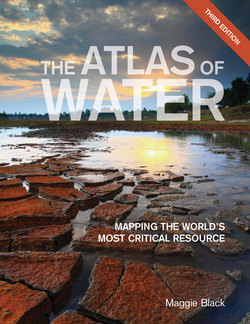Читать книгу The Atlas of Water - Maggie Black - Страница 14
На сайте Литреса книга снята с продажи.
ОглавлениеGlossary
aquifer – a natural underground layer, often of sand or gravel, that contains water; some aquifers are very deep and in hard rock, and have taken millions of years to accumulate their supply. billion – a thousand million. blue water – water withdrawn from lakes, rivers and aquifers for irrigation. brackish water – water that is neither fresh nor salt. consumptive use – water that is used in, for example, manufacturing, agriculture and food, which is not therefore returned to a water resource. It excludes evaporation, which eventually returns to earth as rain. desalination – the changing of salt or brackish water into fresh water; see also reverse osmosis. evaporation – the process of liquid water becoming water vapour, including vaporization from water surfaces, land surfaces, and snow fields, but not from leaf surfaces. evapotranspiration – both evaporation and transpiration (the process by which water is evaporated from a plant surface, such as leaf pores). fresh water – water that contains fewer than 1,000 milligrams per litre of dissolved solids. green water – rain water, in the context of agriculture groundwater – water that lies deep underground in aquifers. Normally free of contamination, it is regarded as a safe source of drinking water. impoundment – control of water by dam or embankment to prevent water from flowing along its natural course. improved sanitation – toilet facilities that hygienically separate human excreta from human contact. These include “wet” systems, where water in a U-shaped pipe creates a seal, and which may be connected to a sewer or septic tank, and “dry” systems such as a pit toilet with a cleanable squat plate, cover and solidly constructed pit. Sanitation is considered adequate if it can effectively prevent human, animal and insect contact with faeces; this excludes public toilets in most settings. improved water source – a water source with protection from contamination, such as a household connection to a safe piped supply or a public standpipe similarly connected; a borehole or protected well; a covered spring or rainwater collection system. internal renewable water resources – average annual flow of rivers and recharge of groundwater generated from precipitation falling within the country’s borders. leaching – the process by which soluble materials in the soil, such as salts, nutrients, pesticide chemicals or contaminants, are washed into a lower layer of soil, or are dissolved and carried away by water. melt-water – water produced by the melting of snow or ice. precipitation – rain, snow, hail, sleet, dew, and frost. renewable resources – total resources offered by the average annual natural inflow and run-off that feed a catchment area or aquifer; natural resources that, after exploitation, can return to their previous stock levels by the natural processes of growth or replenishment. reverse osmosis – a desalination process that uses a semi-permeable membrane to separate and remove dissolved solids, viruses, bacteria and other matter from water; salt or brackish water is forced across a membrane, leaving the impurities behind and creating fresh water. river basin – the area of land drained by a river and its tributaries. A basin is considered “closed” when its water is over-committed to human uses, and “closing” when it is approaching that state. run-off – the movement of rain water over ground. salt water – water that contains significant amounts of dissolved solids. sewerage – a system of pipes with household connections to larger receptor and interceptor pipes and tunnels, that carries off waste matter, either to a treatment plant or directly to a river or stream. surface water – water pumped from sources open to the atmosphere, such as rivers, lakes, and reservoirs. unimproved water source – vendor, tanker trucks, and unprotected wells and springs. wastewater treatment – the process of turning contaminated water into water that can be re-used for a range of purposes, depending on the level to which it has been treated. water table – the upper level of groundwater in soil. withdrawal – water removed from groundwater or surface water for use.
16
